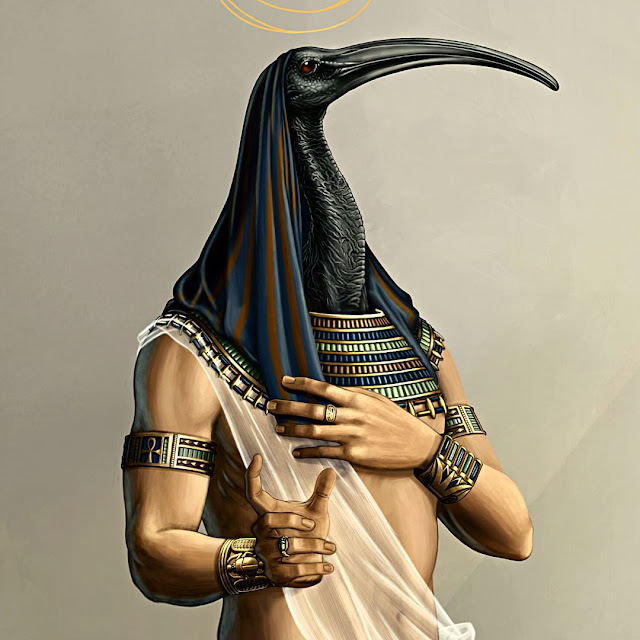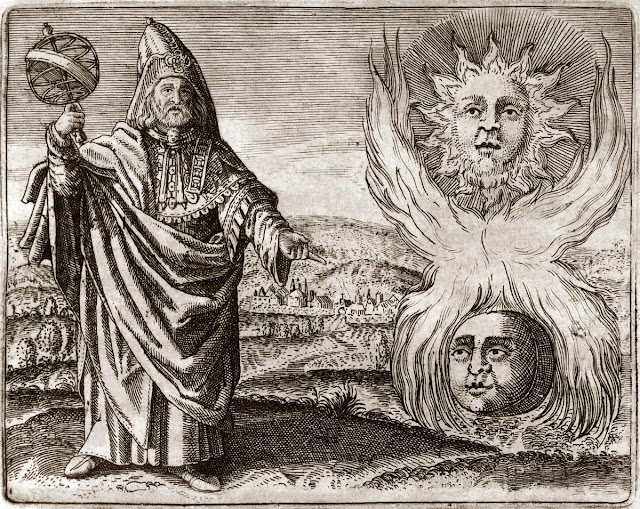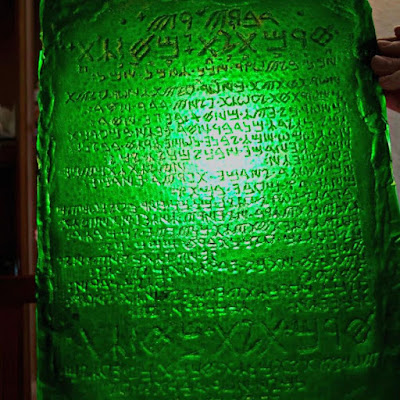Obscure Occurrences : The Emerald Tablets of Toth
Ever since man understood that his time on this earth was finite, the Human Race has been fascinated with the idea of extending their youth to attain immortality. Written by Djehuty aka Thoth, an important Egyptian God who was worshipped before the age of the Pharaohs, The Emerald Tablets have served as a pioneer in this intention. Considered to be the founding text of ancient Egyptian alchemy, the stanzas of the Emerald Tablets are said to contain the recipe of the Philosopher’s stone, the most sought-after secret of Alchemy. In line with legend, this substance could turn base metals into gold, restore youth, and grant Immortality, thus giving it another name, The Elixir of Life. Alchemists have attempted to create this stone for centuries, but it only resulted in the creation of Chemistry.
The History of Thoth
Depicted as a
man with the head of an Ibis, Thoth was the God of magic, wisdom, and the moon.
Egyptians claim that he invented writing, hieroglyphics, science, religion,
philosophy, and Alchemy. Greeks call him the inventor of astronomy, mathematics,
civilized government, and the alphabet. But according to legend, Thoth was
neither a God nor an Egyptian. He arrived in Egypt thousands of years ago,
bringing with him the knowledge and wisdom from his own country, Atlantis.
 |
| (Source: Art Station/ Yannick Dubeau) |
Plato described
Atlantis as being divided into ten kingdoms, each with its own government, its
own rulers and its own purpose. One of these kingdoms was the Island of Undal, the
Atlantean Centre of Philosophy and Science. 36,000 years ago, Kaora, an Undal
city filled with scholars, scientists and priests, saw the birth of Thoth.
Thoth was
trained by his father, Thotme, from a very young age. An extremely important
figure in Atlantis, Thotme was one of The Children of Light, an advanced race
that lived alongside humans. He was also “The Keeper of the Great temple”; a
high priest who carried messages from The Children of Light to the human race.
These supposedly superior beings provided the human race with science, language,
and eventually, technology. Some have described these beings as Extra Terrestrials, the Anunnaki, or both. Although these entities would appear God-like to any
normal human being, they were mere mortal beings.
The ten
kingdoms of Atlantis were created by an entity named Horlet, sometimes called The
Dweller. Toth spent many years with Horlet, learning the art of wisdom. His
continued excellence in studies earned him an invitation to The Halls of Amenti,
where he was given the key to Immortality. Thoth, like the other children of
light, was given the ability to reincarnate every hundred years, but as an
immortal, he was also given the responsibility for keeping the ancient
knowledge that he's been taught.
After a great
flood caused Atlantis to see the end of its existence, Thoth, along with many
other teachers, was sent out to establish new colonies around the world and to
preserve the knowledge and culture of Atlantis. For centuries that followed,
Thoth would reincarnate into different bodies, sharing his wisdom with a selected
few. While he was usually born in and around Egypt, his mission would take him to other
parts of the world at times. One of these other “zones of Thoth’s
reincarnation” was ancient Greece, a place where he recorded the secrets of the
universe in tablets carved out of green Emerald. While some believe that the
material might have been Crystal, others say that the tablet was made of Orichalcum,
a valuable ancient metal that, according to Plato, was mined in Atlantis.
Origins of The Emerald Tablet
The Emerald
Tablets are said to have been written by Hermes Trismegistus, a Reincarnation
of Toth himself. He is the author of Hermetica, a group of texts which lay the foundation for a set of spiritual concepts and practices called Hermeticism. The
philosophy has influenced secret societies like the Free Masons, the
Rosicrucians, and the Order of the Black Sun.
 |
| (Source: MWM) |
The earliest
known mention of The Emerald Tablets comes from an Arabic text dated 1200 years
ago, but this text claims to be a translation of a much older work. Since their
discovery, the Emerald Tablets became one of the most studied documents by
Islamic and European alchemists. It also became popular with occultists, who
often used its second verse as their motto. However, these were all just
translations and the original tablets had been lost at some point in time.
 |
| (Source: Etsy) |
While the
Emerald Tablets are said to be ten in number, they are divided into three
parts. The last two of these sections are so great and far-reaching in their
importance that they are forbidden to be released freely into the world. They allegedly
hold secrets that can only reach those who are serious about learning and
seeking wisdom.
In the Hands of Apollonius
Sometime in the
First Century AD, Apollonius of Tyana, a Greek Hermetic philosopher who was also
called the Lord of Talismans and Wonders, was studying in the city's library
when he came across a mysterious book. It was bound in green leather and its pages
were made of a material that he had never seen before. The book was written in
a language that he didn't recognize and its pages were filled with strange
symbols and diagrams. Apollonius studied the book and realized that it was a
book of alchemy filled with the secrets of the universe and the hidden forces
of nature.
Determined to uncover the mysteries of the book, Apollonius set out on a quest to find its author. After a long search, he came to a remote temple in the mountains where he met an oracle, who told him where to look for answers. He was given directions to a secret subterranean chamber underneath the statue of Hermes in Tyana. At the end of a dark whining passage, Apollonius found the corpse of Hermes Trismegistus, sitting on a Golden Throne.
Still clutched in his withered
skeletal fingers, Hermes had a dusty book, whose title read “The Secret of
Science and The Cause of Things”, and a tablet carved from a single piece of
translucent green stone, which read “The Art of Nature.” Apollonius took the
Emerald Tablet and the book before sealing the cave. Shortly afterwards, he incorporated
these newfound secrets of alchemy into his own work, but then the Emerald
Tablet was lost again.
Apollonius
wrote that he gave the tablet to the Roman Emperor Hadrian, who buried it under
his Palace. However, some think the tablet
was present in the Library of Alexandria when it burnt. Early stories state
that the tablet was hidden by Alexander the Great in the Great Pyramid of Giza.
They also correspond with claims that the emerald tablet was publicly displayed
in Egypt in 316 BC, seven years after Alexander's Death.
“The Emerald Tablets of Thoth the Atlantean”
In 1925, a man
named Dr Maurice Doreal claimed to have come in contact with all 10 Emerald Tablets
during his time in Egypt. He allegedly made his own translations of the stanzas
in the tablet, before publishing them as a book in 1939. The man went on to
establish The Brotherhood of the white temple, a religion that still exists and
has a following.
 |
| (Source: Mirabilia) |
Dr Doreal’s book, The Emerald Tablets of Thoth
the Atlantean, suggests that ancient civilizations had Advanced Technologies
and Knowledge, whose details have been lost over time. However, a large part of
the book covers alchemy and how it can be used for transforming base metals
into gold, curing illness, granting immortality, and achieving enlightenment. But
unlike the original Emerald Tablets, it was all allegory and symbolism, subject
to many different interpretations.
That being
said, Dr Maurice Dorel's real name was Claude Doggins. While he claimed that he
had the ability to read and write soon after his birth, he never graduated high
school. Furthermore, there is no record of him receiving a doctorate or
travelling to Egypt, and his works were lifted from the works of prominent science
fiction writers. To add on, in front of a whole group of his disciples, his
wife called him out for lying and cheating. Despite these facts, Dr Doreal
still has a lot of believers, but they add no weightage to the man’s
non-existent credence.
Conclusion
Over centuries,
multiple scholars and philosophers including Sir Isaac Newton have tried to
interpret the true meaning of the cryptic stanzas of the Emerald tablets, but
to no avail. The discovered text remains marvelled over, re-translated and reinterpreted
even in the modern day. The most common interpretation of the tablets is that it is
a codified recipe, describing the seven stages of the alchemical transmutation of base
metal into gold within a laboratory.
However, in
retrospect on the dark history of alchemy, modern occultists have put forward
their own theory for what the emerald tablets’ cryptic message actually means. They
claim that the tablets do not teach one how to convert base metals into gold
nor contain a recipe of the legendary philosopher's stone, but that the
alchemical process is an allegory for the development of the soul and the
understanding of oneself.
Considering
that the material we have in hand is merely the interpretation of the original Emerald
Tablets, there is an underlying possibility of it being completely wrong. We
might know the text's original meaning only if we get hold of the actual
artefact that holds the lost knowledge of Thoth, which has stayed in the lost
pages of history for centuries together.
Post a Comment